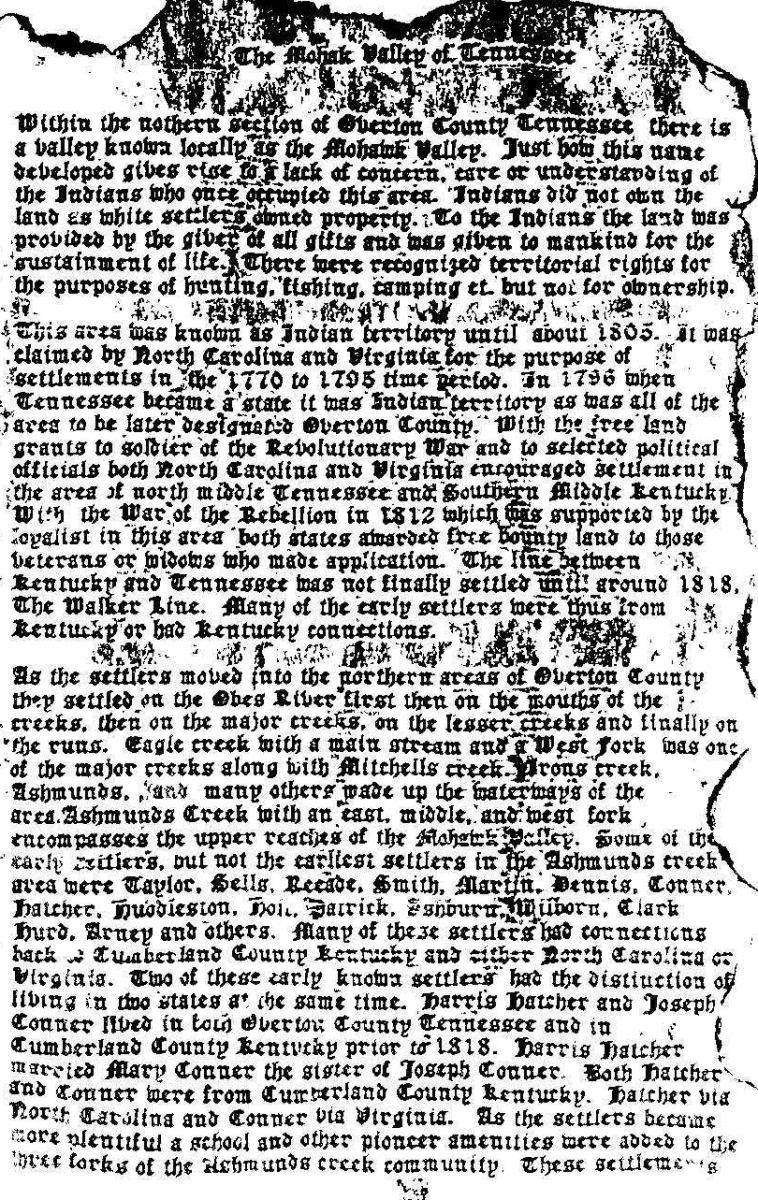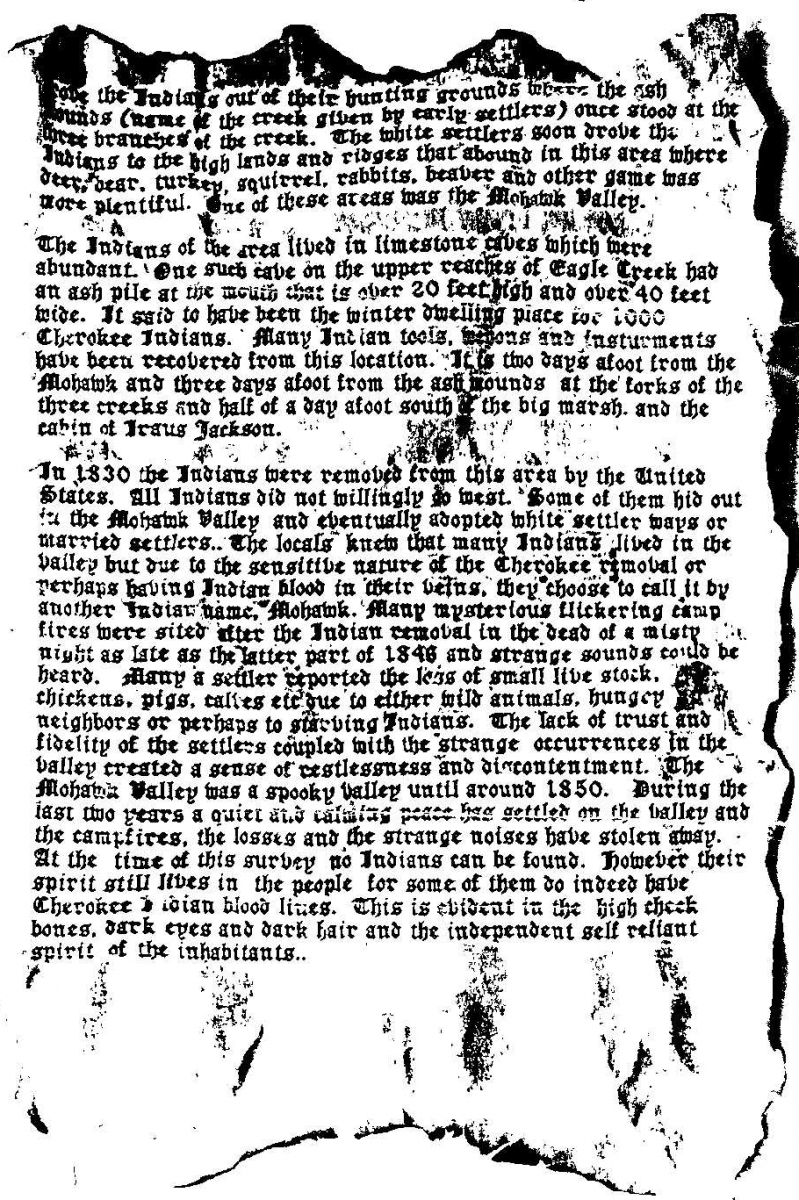Mohawk Valley of Overton County
Contributed by Cleston Conner, who received the information from the Society of the Descendants of Washington’s Army at Valley Forge. Origin is unknown. Date may be about 1852. Transcribed by Tami Ramsey.


The Mohawk Valley of Tennessee
Within the Northern section of Overton County Tennessee there is a valley known locally as the Mohawk Valley. Just how this name developed gives rise to a lack of concern, care or understanding of the Indians who once occupied this area. Indians did not own the land as white settlers owned property. To the Indians the land was provided by the giver of all gifts and was given to mankind for the sustainment of life. There were recognized territorial rights for the purposes of hunting, fishing, camping, et. But not for ownership.
This area was known as Indian Territory until 1805. It was claimed by North Carolina and Virginia for the purpose of settlements in the 1770 to 1795 time period. In 1796 when Tennessee became a state it was Indian territory as was all of the area to be later designated Overton County. With the free land grants to soldier of the Revolutionary War and to selected political officials both North Carolina and Virginia encouraged settlement in the area of north middle Tennessee and southern middle Kentucky. With the War of the rebellion in 1812 which was supported by the loyalist in this area both states awarded free bounty land to those veterans or widows who made application. The line between Kentucky and Tennessee was not finally settled until around 1818. The Walker line. Many of the early settlers were thus from Kentucky or had Kentucky connections.
As the settlers moved into the northern areas of Overton County they settled on the Obes River first then on the mouths of the ctreeks, then on the major creeks, on the lesser creeks and finally on the runs. Eagle creek with a main stream and a West fork was one of the major creeks along with Mitchells Creek, Irons creek, Ashmunds, and many others made up the waterways of the area. Ashmunds creek with an east, middle and west fork encompasses the upper reaches of the Mohawk Valley. Some of the early settlers, but not the earliest settlers in the Ashmunds creek area were TAYLOR, SELLS, REEIDE, SMITH, MARTIN, DENNIS, CONNER, HATCHER, HUDDLESTON, HOLT, PATRICK, ASHBURN, WILBORN, CLARK, HURD, ARNEY and others. Many of these settlers had connections back to Cumberland County Kentucky and either North Carolina or Virginia. Two of these early known settlers had the distinction of living in two states at the same time. Harris HATCHER and Joseph CONNER lived in both Overton County Tennessee and in Cumberland County Kentucky prior to 1818. Harris HATCHER married Mary CONNER, the sister of Joseph CONNER. Both HATCHER and CONNER were from Cumberland County Kentucky. HATCHER via North Carolina and CONNER via Virginia. As the settlers were added to the three forks of the Ashmunds creek community. These settlers drove the Indians out of their hunting grounds where the Ash mounds (name of the creek given by early settlers) once stood at the three branches of the creek. The white settlers soon drove the Indians to the high lands and ridges that abound in this area where deer, bear, turkey, squirrel, rabbits, beaver and other game was more plentiful. One of these areas was the Mohawk Valley.
The Indians of the area lived in limestone caves which were abundant. One such cave on the upper reaches of Eagle Creek had an ash pile at the mound that is over 20 feet high and over 40 feet wide. It is said to have been a winter dwelling place for 1000 Cherokee Indians. Many Indian tools, weapons, and instruments have been recovered from this location. It is two days afoot from the Mohawk and three days afoot from the ash mounds at the forks of the three creeks and half a day afoot south of the big marsh and the cabin of Irsus JACKSON.
In 1830 the Indians were removed from this area by the United States. All Indians did not willingly go west. Some of them hid out in the Mohawk Valley and eventually adopted white settler ways or married settlers. The locals knew that many Indians lived in the valley but due to the sensitive nature of the Cherokee removal or perhaps having Indian blood in their veins they chose to call it by another Indian name, Mohawk. Many mysterious flickering campfires were sited after the Indian removal in the dead of a misty night as late as the latter part of 1846 and strange sounds could be heard. Many a settler reported the loss of small livestock, chickens, goats, pigs, calves, etc. but to either wild animals, hungry neighbors or perhaps starving Indians. The lack of trust and fidelity of the settlers coupled with the strange occurrences in the Valley created a sense of restlessness and discontentment.
The Mohawk Valley was a spooky Valley until around 1850. During the last two years a quiet and calming peace has settled on the valley and the campfires, the losses and the strange noises have stolen away. At the time of this survey no Indians can be found. However their spirit still lives in the people for some of them do indeed have Cherokee blood lines. This is evident in the high cheek bones, dark eyes and dark hair and the independent self reliant spirit of the inhabitants.
